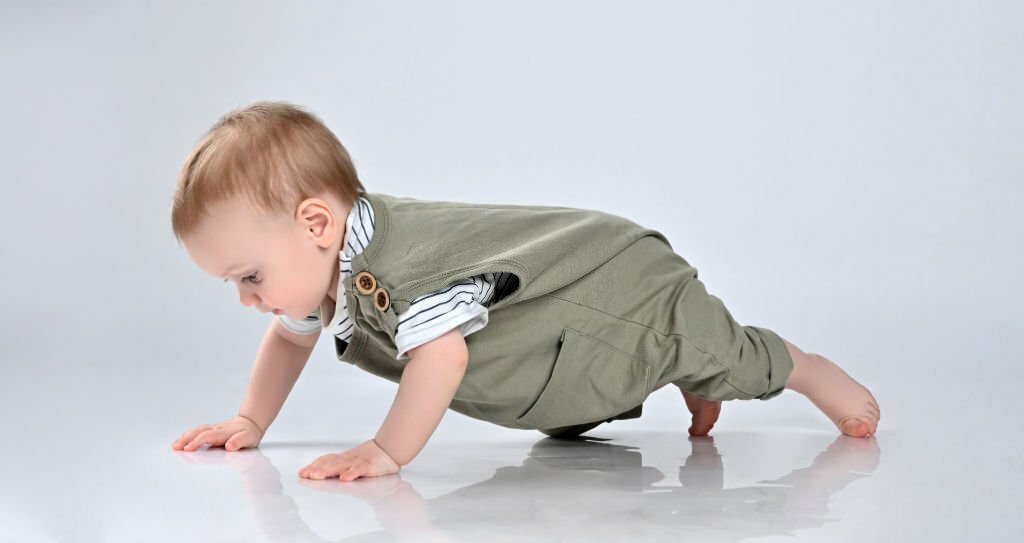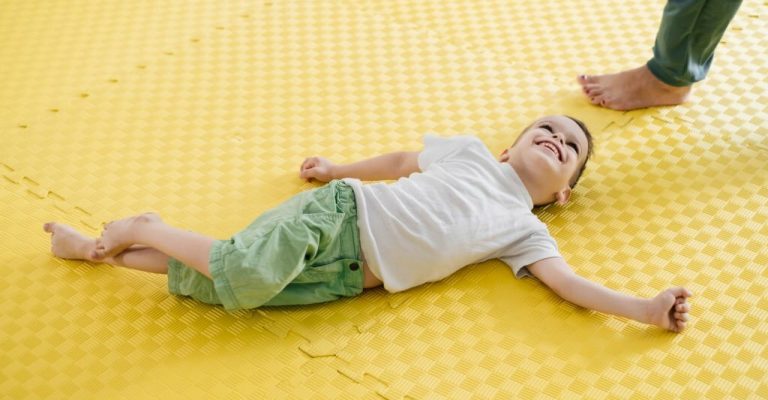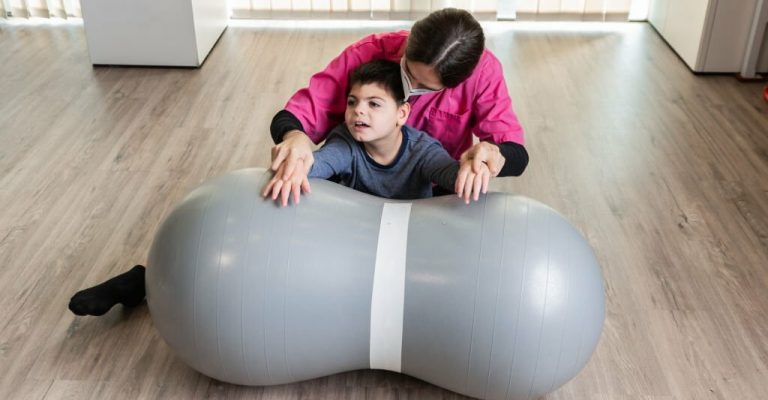Have you ever noticed a baby crawling on the floor with their hands and legs dragging behind them? For most of us, it’s a natural developmental stage that we all go through. However, crawling like this can be challenging for children with cerebral palsy (CP). In fact, traditional crawling on all fours may not even be an option for some. Let’s learn more about it!
What is Commando Crawling?
Commando crawling, more commonly known as military crawling, is a type of crawling where a person propels themselves forward using their arms and legs. It’s a popular way that babies learn to crawl before they fully learn to walk.
When children start commando crawling, they typically lift their upper body off the ground with their arms and then drag their lower body behind them. It’s a unique way of crawling because, unlike traditional crawling, it doesn’t require as much coordination and balance. Babies can quickly figure out how to move along the ground, even if they’re not ready to walk yet.
What’s fascinating about commando crawling is that it’s relatively similar to how soldiers trained in the military crawl on the ground when trying to remain hidden from the enemy. The only real difference is that soldiers also incorporate their elbows to move along, which babies tend to omit in their movements.
As babies get more experienced with commando crawling, their movements become more coordinated and deliberate. They start using their hips and core muscles more to propel themselves forward, and you can see them getting faster and more efficient at moving across the ground.
While commando crawling might seem harmless, it’s actually a crucial phase in a baby’s development. It helps them build up their strength and coordination, which is essential for developing their future gross motor skills. Without commando crawling, babies might not develop the strength and coordination necessary to crawl on all fours or walk as they should. But is it normal for a CP child, too? Let’s know!
Is There a Reason Cerebral Palsy Kids Commando Crawl?

Cerebral palsy is a neurological disorder that hampers voluntary muscle movement, balance, and coordination. This condition is predominantly observed in childhood and can profoundly impact a child’s physical abilities.
One common manifestation of cerebral palsy is spastic diplegia, which involves heightened muscle tone in the legs. As a result, affected children tend to experience stiffness and struggle to control their lower extremities. This, in turn, can lead to developmental delays.
During the course of their development, children often crawl as a critical milestone that marks the transition from babyhood to early childhood. However, children with cerebral palsy, particularly those with spastic diplegia, may adopt a unique variation of crawling known as commando crawling. In this method, children move forward on their stomachs, using their arms to drag their bodies and push themselves forward.
Interestingly, commando crawling may not always be attributed to leg muscular weakness. Instead, it could stem from a lack of core strength. Crawling is an activity that engages the entire body, requiring a synchronized coordination of the arms, legs, and core. Without a strong core, children may struggle to execute movements that need both balance and bilateral coordination.
Therefore, it is crucial to identify the root cause of commando crawling in children with cerebral palsy. Through targeted interventions such as physical therapy, occupational therapy, and specialized equipment, children with cerebral palsy can enhance their physical abilities and improve their quality of life. Ultimately, early detection and timely intervention are key to empowering children with cerebral palsy and enabling them to reach their full potential.
Long-term Commando Crawling and Its Effects on Cerebral Palsy Children
If you’re noticing that your little one has been commando crawling for a while, it’s essential to be aware of the potential problems it can cause. Though many children with cerebral palsy who commando crawl can eventually stand and walk, those who continue with this crawling pattern for too long can experience several issues.
In traditional crawling, babies use their arms and legs to move forward. But with commando crawling, they drag themselves along the ground using only their arms, neglecting their leg and core muscles.
The problem is that our muscles quickly adapt to our habits – or lack thereof. When we don’t use certain muscles, they become weaker and less responsive. This can lead to difficulty standing and walking as kids get older.
And it’s not just muscle weakness you need to be aware of. Individuals with cerebral palsy may also experience spasticity when muscles contract involuntarily. This can significantly limit a child’s mobility and independence in severe cases. To help prevent these problems, try encouraging your child to transition to traditional crawling as soon as possible.

Helping a Child Who Commando Crawls Due to Cerebral Palsy
Cerebral palsy affects different people in different ways, and one of the ways it can manifest is through commando crawling. Commando crawling is a way of moving in which the child drags their body along the floor using their arms and legs.
If you are a parent or caregiver of a child with cerebral palsy who commando crawls, here are some tips to help them:
Understand Your Child’s Needs and Abilities
The first step in helping a child with cerebral palsy who commando crawls is understanding their needs and abilities. Every child with cerebral palsy is unique, so it is crucial to work with their healthcare provider to determine what they can and cannot do.
For example, some children with cerebral palsy may have more upper-body strength than lower-body strength, making it easier for them to commando crawl. Other children may have difficulty lifting their heads or coordinating their movements.
By understanding your child’s needs and abilities, you can develop a plan to help them move more effectively and efficiently.
Encourage Movement and Exercise
Children with cerebral palsy benefit from movement and exercise. These activities can help improve their muscle tone, flexibility, and coordination. Encourage your child to move and play whenever possible.
If your child struggles with traditional exercise, such as walking or running, consider alternative activities like swimming or horseback riding. The more your child moves, the stronger and more flexible their muscles will become, and the easier it will be for them to commando crawl.
Provide Assistive Devices and Adaptive Equipment
Assistive devices and adaptive equipment can help children with cerebral palsy move more efficiently and safely. Some examples of assistive devices include ankle-foot orthotics (AFOs), braces, and walkers.
Adaptive equipment can include special chairs and positioning devices that can help support your child’s posture, making it easier for them to commando crawl. Work with your child’s healthcare provider to identify the best assistive devices and adaptive equipment for your child’s needs.
Create a Safe and Accessible Environment
Creating a safe and accessible environment is essential for helping a child with cerebral palsy who commando crawls. Ensure your home is free of hazards and your child can move around easily.
You may need to modify your home, such as installing ramps, widening doorways, and removing obstacles that could hinder your child’s movement. In addition to home modifications, consider creating an accessible play area for your child. This could include soft play mats and other equipment to help your child move and play safely.
Celebrating Milestones, Big and Small
Milestones mark every journey, and this one is no exception. Imagine the joy in celebrating those small victories—the first independent crawl across the room, the triumphant reach for a cherished toy. This reinforces the child’s confidence and motivation. Picture a continuous cycle of progress and celebration, building a foundation for future achievements.
Encouraging Independence Through Play
Children learn best through play, which holds true for those with cerebral palsy. Introduce toys and activities that capture their interest and motivate them to move. Low-lying toys or objects strategically placed within their reach can serve as incentives for commando crawling. This promotes physical activity and fosters a sense of accomplishment and independence.
Emotional Support for Caregivers
Supporting a child with cerebral palsy requires emotional strength from caregivers. Acknowledging the challenges, celebrating small victories, and seeking assistance when needed is essential. Joining support groups or connecting with other parents facing similar situations can provide a valuable network for sharing experiences and coping strategies.
Final Thoughts
A child with cerebral palsy can command crawls due to their condition, making traditional crawling difficult for them. Despite the complications of the situation, parents or caregivers can support the child by encouraging other ways of movement and self-exploration.
Encouraging self-exploration is vital to the cognitive and motor development of the child. Focusing on building core strength and providing adequate support also goes a long way in helping the child who commando crawls due to cerebral palsy. Always remember to involve an expert for professional help.

